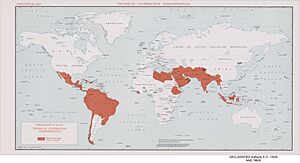Point Four Program facts for kids
The Point Four Program was a special plan started by United States President Harry S. Truman. He announced it in his speech when he became president on January 20, 1949. This program was about helping "developing countries" (nations that were still growing and needed help with their economy and way of life) by sharing American skills and knowledge. It was called "Point Four" because it was the fourth important goal Truman talked about in his speech for America's foreign policy (how a country deals with other countries).
Contents
Why the Program Started
The Cold War and Helping Other Nations
By 1947, the United States was in a big rivalry called the Cold War with the USSR. The US government wanted to win the support of countries around the world, especially those that were still developing. Many of these nations in the Middle East, Latin America, Asia, and Africa felt that the US was only focusing on helping Europe.
So, President Truman's team came up with the idea for the Point Four Program. They wanted to share American "know-how" (skills and knowledge) in areas like farming, industry, and health. The goal was to help these "third world" nations grow, improve how people lived, and show that democracy and capitalism (a system where businesses are mostly owned by private people, not the government) could make life better for everyone.
President Truman's Vision
In his speech, President Truman said that the US should start a "bold new program." This program would share America's scientific and industrial progress to help "underdeveloped areas" of the world. He explained that many people lived in poverty, suffered from disease, and had very basic economies. Truman believed that for the first time, humanity had the knowledge to help these people. He stressed that the US had great skills in science and industry, and these skills were endless.
Truman made it clear that this program was not about taking over other countries. He said that the old way of "imperialism" (where one country controls another for its own gain) had no place in their plans. Instead, he wanted a program based on fairness and democracy. He believed that all countries, including the US, would benefit from using the world's human and natural resources better.
Support for the Program
The Point Four Program was not about giving huge amounts of money like the Marshall Plan (which helped rebuild Europe after World War II). Instead, it was about sharing technical skills and advice. Both major political parties in the US supported it, including Republican Congressman Christian Herter.
This program was the first time the US offered global foreign aid. It was inspired by an earlier program called the Office of the Coordinator of Inter-American Affairs (OCIAA), which had given technical help to countries in Latin America. Nelson Rockefeller, who ran the OCIAA, strongly supported the Point Four Program.
How the Program Worked
Getting Started
To make the program happen, a new group called the Technical Assistance Group was formed in the Department of State in February 1949. The US Congress officially approved the program on June 5, 1950. They gave it a budget of $25 million for the first year. President Truman said that the program would show that free nations could provide a good life for people in developing areas, proving communist ideas wrong.
After Congress approved it, the Technical Cooperation Administration (TCA) was created on October 27, 1950. This new organization, part of the Department of State, was in charge of running the Point Four Program. The OCIAA was also included in this new group.
Helping Countries Around the World
The Point Four Program worked by making special agreements between the US government and the governments of other countries. Once an agreement was made, the TCA set up missions in those countries. These missions helped improve farming methods and shared technical knowledge to boost the economy in general. The first country to sign such an agreement was Iran, on October 19, 1950.
Unlike some other aid programs, Point Four was not limited to just one part of the world. It helped countries like Pakistan, Israel, and Jordan. For example, India received a lot of technical help from 1950 to 1951. This included building a penicillin factory, increasing the number of schools and medical research centers, and constructing dams. The US hoped that by helping India economically, it would also encourage India to remain a democratic government and not become allies with the Soviet Union or China.
Later, when Republican President Dwight D. Eisenhower took office, he changed the name from "Point Four Program" to simply "technical assistance program." He also reorganized the TCA into the Foreign Operations Administration. Today, similar work is done by the Agency for International Development.
What the Program Achieved
The Point Four Program was the first US plan designed to improve social, economic, and political conditions in "underdeveloped" nations. It made international development policy a central part of how the US dealt with other countries.
Even though the program aimed to help nations, some people later saw its legacy as being partly about America's own interests. The US improved its access to important raw materials from these countries, but the program didn't always significantly reduce poverty in the partnered nations. The difficult time after World War II, the growing threat of communism, and not enough money from Congress and American businesses led to the program's challenges.


